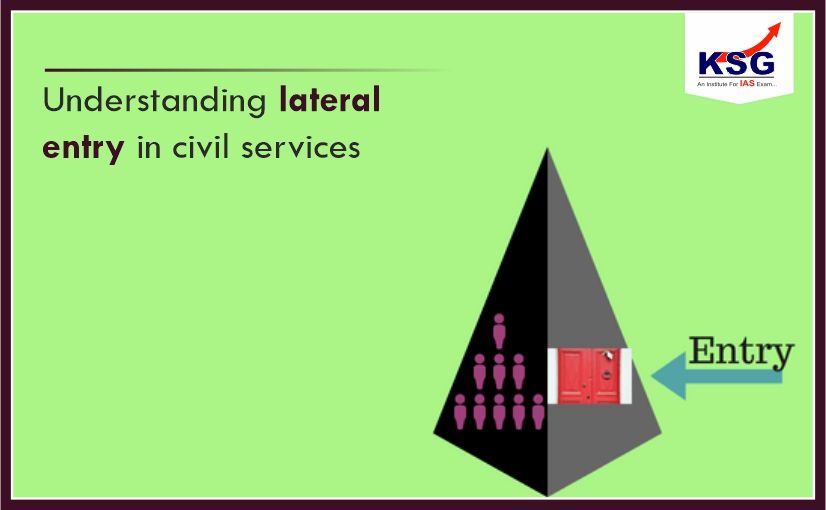Understanding Lateral Entry in Civil Services Exam
Lateral entry was recently got attention when Prime Minister’s office had asked Department of Personnel and Training to prepare a proposal for lateral entry of professionals into the middle levels of the civil services in ministries.
Understanding Lateral Entry in Civil Services Exam
Lateral entry was recently got attention when Prime Minister’s office had asked Department of Personnel and Training to prepare a proposal for lateral entry of professionals into the middle levels of the civil services in ministries. Second report of ARC recommended the need of formalized procedures for such entry and after this report lateral entry in civil services is debated. Civil servants themselves was resisting it.
Lateral entry means the appointment of specialists from private sector in government organizations. Nine private sector specialists were appointed as joint secretaries by government recently in various department through lateral entry. Personnel ministry invited applications for the joint secretary rank posts through lateral entry mode in revenue, financial services, economic affairs, agriculture and farmer’s welfare, road transport and highways, shipping, environment, forest and climate change, new and renewable energy, civil aviation and commerce departments.
The task was given to UPSC to select candidates from 6,000 received applications. Selected candidates were Amber Dubey (civil aviation), Arun Goel(commerce), Rajeev Saksena (Economic Affairs), Sujit Kumar Bajpayee (environment, forest and climate change), Saurabh Mishra (financial Services) and Dinesh Dayanand Jagdale (new and renewable energy), Suman Prasad Singh (road transport and highway ministry), Bhushan Kumar(Shipping)and Kakoli Ghosh (agriculture, cooperation and farmer welfare).
Why Lateral entry:
To infuse the private sector corporate culture in public sector the idea of lateral entry in Indian civil services was designed. Few more concrete shortfalls of civil servants made the lateral entry need of the hour. Corruption, stagnation and insufficiency are few allegations that civil servants face. Recently Baswan committee report said that states like Madhya Pradesh, Rajasthan and Bihar need 75 to 100 more officers.
Lateral entry fills this gap and initial recruitment hustle bustle is also avoided. It is believed that civil servants don’t have specified domain knowledge though there are sectors where officers with specific domain knowledge are needed. With the nature of job and frequent transfers officers don’t have much scope to develop expertise. It is expected that lateral entry will bring individuals with domain expertise and better efficiency due to target oriented nature of private sector.
Let’s know about pros and cons of lateral entry:
Pros of Lateral Entry:
- Until now lack of specialization in civil servant is unaddressed.
- IAS officers sometimes have deficiency in their judgement and administrative capabilities because of early age recruitment. Some master it with passing time but some may not. Lateral entry allows professionals with expertise to join the league and make up for this.
- Experts joining the league from professional environment will change the work culture of the bureaucrats.
- Government has brought professionals from private sector before also and that to the top tier of government. Finance ministry, Reserve bank of India and even Niti Ayog are few of them which have proved to be successful in every way.
Cons of Lateral Entry:
- Difference in work culture is the matter of concern in inter sector scenario. Lateral entry of professional from private sector and academics may not be in sync with bureaucracy.
- Transition and establishing authority should be handled with great accuracy as candidates joining in from outside may not be aware with the system which can be a matter of concern in many ways.
- Candidates who have made it through the toughest competitive exam may feel demotivated when someone without having to face such challenge are given a chance to work neck to neck with them.
- Most of the IAS are from the village or rural areas having experience of field and knowing the real face of the country. But those entering from private sector don’t have any such experience which makes it difficult for them to actually take the challenge and work for masses.
- Hiring professionals through lateral entry may be sometime a concern as they may not understand the process and proceedings of the government thoroughly. But a good civil servant knows the process well and can advise government with that.
Lateral entry in civil services is not a new concept but it was never conceptualized in proper manner. It should follow a strict procedure. Civil services are back bone of Indian administration, though it needs reforms for sure. Lateral entry gives the power and positions to the individuals who are from corporate culture and they must be educated and trained well before they take the lead. Internal reforms are required to improve the efficiency at the same time defined structure must be developed to allow professionals into civil services through lateral entry.

